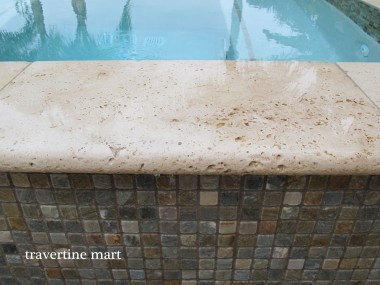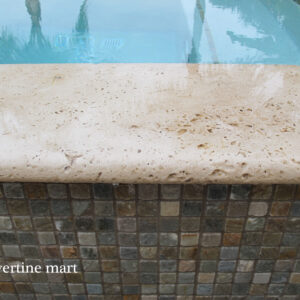With the new trend in salt water pools comes the worry of just how to protect your patio against the damaging effects the salt water has on the travertine pavers and surrounding pool coping. It has long been known that salt water damages travertine but, to what extent, and, is it really worth the worry?
First, the bad news: When salt water comes into contact with Travertine, “Salt water attack,” as it is commonly called, can happen 3 different ways:
1) Efflorescence: salt water absorbs into the stone’s pores and leaves behind a white, chalky residue. This residue, if caught soon enough, can usually be swept off with a broom. But if left long enough, you’ll need to acid wash the stone to remove it.
2) Spalling: this method is very similar to efflorescence, however, spalling is when pits begin to form in the travertine because salt water crystals are trapped beneath the surface of the stone.
3) Leeching: since natural stone is, well, natural, it can contain salt within the stone, beneath the surface. When water absorbs into the stone, the salt dissolves, leaving empty pockets, and weakens the stone.
The good news? It’s not as scary as it sounds.
Travertine can safely be used around a salt water pool as long as the appropriate measures are taken to protect it.
A high quality water-repellant, impregnating sealer should be used on the travertine, giving reasonable protection for 5-10 years.
Below is an image of untreated, unsealed, completely natural travertine pool coping that has been exposed to salt water everyday for 2 years. You can begin to see the effects of Spalling.
The most interesting part is, the owner of the pictured travertine below, likes the effect salt water had on her travertine and does not want to seal it.





















